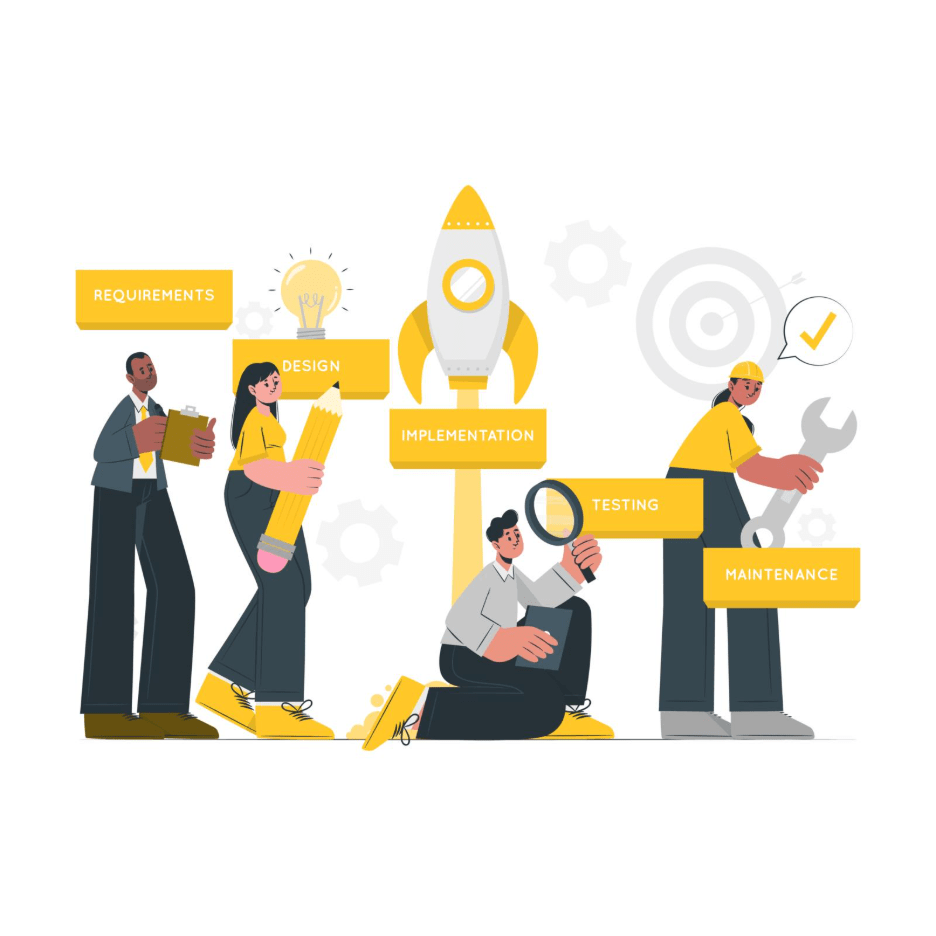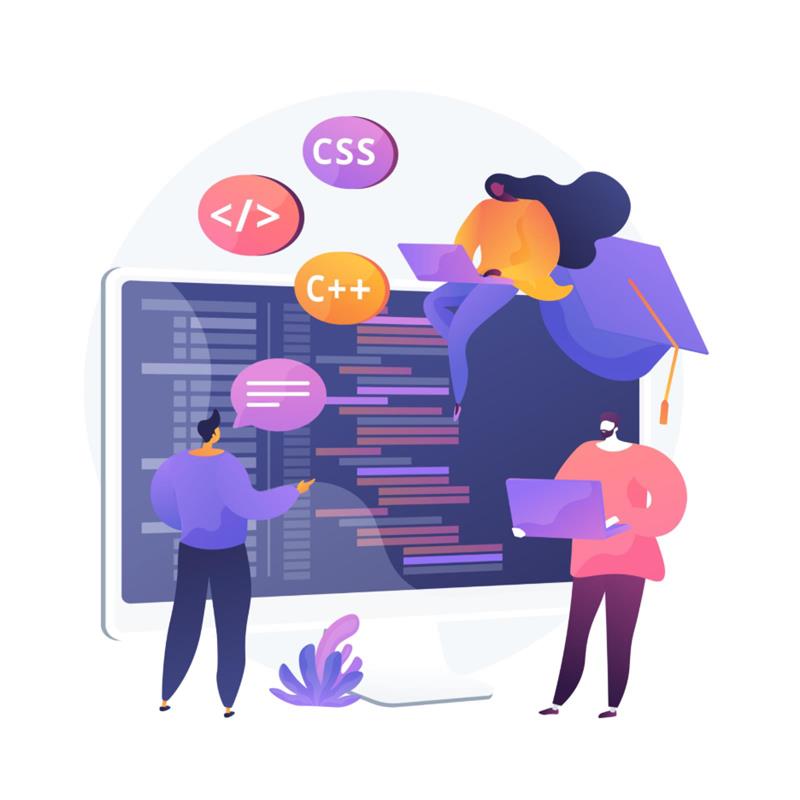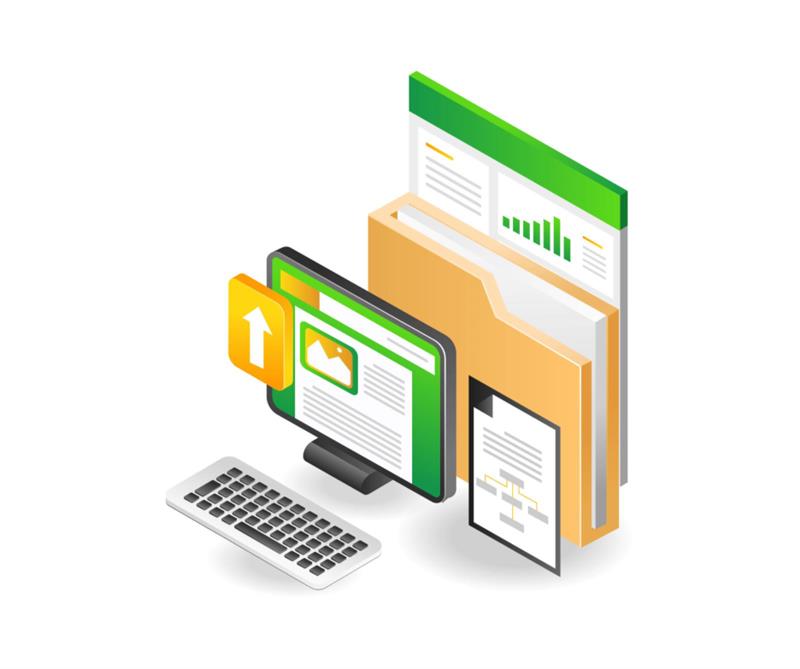Building modern software is a high-stakes game where success is harder to achieve than most teams admit. Only 29% of projects are delivered on time, within budget, and meeting their goals.
More than half encounter serious delays caused by shifting requirements or breakdowns in communication, and nearly one in five fails completely. Scope creep, vague specifications, talent shortages, budget overruns, and the complexity of adopting new technologies all pile on to make delivery even harder.
This is where AI in SDLC is proving to be a turning point. It is no longer just an experimental tool but a proven way to tackle long-standing SDLC problems. From automating repetitive coding tasks to improving requirement analysis and generating accurate test cases, AI is changing how software is planned, built, and maintained.
8 Ways AI in SDLC Eliminates Development Challenges
Here Are 8 Ways You Can Use AI in SDLC to Improve Collaboration and Reduce Handoffs:

1. Accelerates Requirements Gathering and Planning
AI doesn’t just speed up planning. It improves clarity, alignment, and readiness across teams by catching what humans often miss. Here’s how:
AI-driven Gap and Ambiguity Analysis
Suppose a business analyst writes, “The system should load quickly.” What does “quickly” even mean? AI will flag this vagueness and suggest replacing it with something like “within 2 seconds.” That one small fix can prevent endless clarification emails and misaligned expectations.
Automated Traceability and Change Impact
Imagine the login flow gets updated to include multi-factor authentication. AI automatically surfaces all related user stories and test cases, such as login timeout handling or mobile verification, to flag what needs updating. This helps eliminate last-minute surprises in QA.
Stakeholder Sentiment and Risk Detection
In early project calls, a stakeholder keeps bringing up data privacy concerns in chat. AI picks up the repeated pattern, flags it as a risk, and prompts the team to involve security early. This proactive approach helps avoid costly rework later.
Real-time Collaboration and Brainstorming
During a remote feature ideation session, team members add ideas into a shared document. AI clusters them into themes, generates three possible user flows, and helps prioritize them. Everyone leaves the meeting aligned instead of overwhelmed.
Test Scenario and Acceptance Criteria Generation
As the team captures a user story for password reset, AI suggests test scenarios such as expired link, wrong OTP, and email not found. QA gets a head start instead of being looped in weeks later.
Standardization and Objectivity
One team writes “app shows prompt” while another writes “system shall notify.” AI nudges both to use consistent phrasing like “The system shall display...” so that requirements are not misinterpreted across teams.
Continuous Requirement Evolution
A couple of weeks after launch, AI spots repeated support tickets about users getting stuck during onboarding. It recommends adding a tooltip and logs it as a new user story, ensuring the product evolves based on real-world use.
📌 Did You Know?
AI can auto-generate acceptance criteria in JIRA from user stories, ensuring 85%+ accuracy and cutting rework. In our pilots, BAs and QAs reviewed AI-suggested ACs inside JIRA itself, improving clarity before development began.
Confused about which SDLC model suits your project? Explore our in-depth guide to choose the right methodology and steer your development journey with confidence.
2. Automates and Enhances System Design
Designing scalable, secure, and efficient systems takes deep expertise, but AI is helping teams move faster without cutting corners. From architecture to compliance, AI enhances every design phase with smart automation and contextual guidance.
Intelligent Architectural Recommendations
When a team starts planning a new platform, AI reviews the requirements and suggests proven architectural patterns. For example, it may recommend a modular microservices structure for scalability or a layered approach for better separation of concerns. This gives the team a strong foundation before they even begin detailed design work.
Automated UI/UX Prototyping
Instead of manually creating every wireframe, a designer can feed AI a few user stories. Within minutes, it produces multiple layout options and clickable prototypes. The team can review, test with stakeholders, and agree on a direction without wasting weeks in iteration cycles.
Design Validation and Scenario Simulation
AI can run virtual simulations to answer questions like “What happens if the system experiences triple the expected traffic?” or “How will performance change if we move to a serverless setup?” These insights allow the team to make informed choices early instead of reacting to problems after launch.
Standards and Best Practice Enforcement
While designs are being refined, AI monitors for potential pitfalls such as tightly coupled modules or poorly defined API boundaries. It prompts the team to align with cleaner, more maintainable structures that will be easier to scale and support.
Automated Documentation Generation
As the design evolves, AI automatically creates and updates architecture diagrams, API call flows, and component maps. This keeps documentation accurate without anyone needing to manually redraw diagrams after every change.
Design Collaboration and Consensus Building
During a design review, AI can summarize key discussion points, list open decisions, and visualize alternative proposals. This makes it easier for distributed teams to agree on next steps and move forward without repeated meetings.
Early Risk and Dependency Analysis
AI highlights hidden dependencies that could cause issues later, such as reliance on unstable third-party libraries or high-latency components. Teams can act on these warnings before they become project blockers.
Security and Compliance by Design
As the system blueprint takes shape, AI scans for missing encryption, insecure data flows, or compliance gaps. This ensures privacy and regulatory requirements are addressed from the start instead of being bolted on at the end.
📌 Did You Know?
With JIRA integration, AI can generate Low-Level Design (LLD) docs automatically. Stories pull metadata like IDs, epics, and requirements, and AI produces a .docx with architecture diagrams and flows — reducing documentation time by 80%.
3. Code Generation and Optimization
This is where AI’s impact is the most visible and measurable. It accelerates development, improves code quality, and supports developers at every step by acting as an active collaborator.
Intelligent Code Autocompletion and Snippets
A developer starts typing a function to upload files. AI predicts the full function, adding not only the core logic but also error handling, file type and size validation, and permission checks. The developer accepts the suggestion instantly, saving significant time and ensuring best practices are followed from the start.
Legacy Code Refactoring
When faced with an old, inefficient codebase, AI scans it for outdated syntax, duplicated logic, and security risks. It recommends breaking large blocks into reusable modules and replaces deprecated encryption methods with modern, secure alternatives. In one case, a simple Python 2 statement is automatically updated to Python 3 format without the developer needing to hunt for syntax changes.
Standards-Aligned Code Suggestions
Teams that maintain coding standards can have AI enforce them in real time. For example, while creating a REST controller, the AI applies preferred dependency injection methods, validates inputs, and structures responses according to team guidelines. This reduces reviewer workload and keeps the codebase consistent.
Context-Aware Function Generation
A developer describes a requirement such as “Create a function to calculate the cart total with discounts and tax.” AI analyzes the existing files, project libraries, and related business rules to generate a complete, tailored function. The result is ready for immediate review and integration.
Test-Driven Development Support
Teams practicing TDD can provide AI with natural-language requirements, and it will generate executable test cases. When code changes, AI suggests additional tests to maintain coverage. This helps identify gaps and prevents critical rules from being missed.
Inline Documentation Assistance
As code is written, AI automatically adds docstrings and inline comments explaining the purpose, parameters, and return values of functions. This keeps documentation current and makes the code easier for new developers to understand without digging through unrelated files.
📌 Did You Know?
AI can auto-generate code review comments in tools like VS and Bitbucket. Inline suggestions, logic-level reviews, and coding-standard checks are pushed back into JIRA subtasks — cutting review turnaround times by 50%.

4. AI-Driven Testing and QA
Testing can take up to a third of total project time. AI helps shift testing earlier in the SDLC and automates key QA activities from start to finish, improving both speed and quality.
Automated Test Case Generation
When a banking app adds a new password recovery process, AI reads the user stories, acceptance criteria, and recent commits. It generates tests for expired reset links, invalid or unregistered emails, and blocked accounts, cutting the scripting effort from days to hours.
Predictive Failure Analysis and Anomaly Detection
If an e-commerce site has a history of checkout failures during peak sales, AI reviews historical logs and test runs to identify the payment service as a likely risk. It triggers extra load testing for that module before release, preventing repeat failures.
Optimized Regression Test Suites
For a SaaS provider with thousands of regression tests, AI maps recent commits to the affected modules and selects only the tests needed for full coverage. This reduces a 14-hour execution cycle to just a few hours, enabling multiple regression runs in a single day.
Self-Healing Automated Tests
When a travel booking site changes a “Book Now” button to “Reserve,” AI recognizes that the underlying element structure is the same. It updates the test scripts automatically so the automation continues to run without manual fixes.
Synthetic Test Data Generation
A telecom company needs realistic datasets to test a new billing engine without violating privacy rules. AI generates synthetic data that mirrors real-world usage patterns while stripping all personally identifiable information, allowing safe and accurate stress testing.
Continuous Testing and Feedback Integration
For a gaming studio pushing daily updates, AI automatically triggers UI and performance tests in the CI/CD pipeline. It flags crashes or performance drops within minutes, giving developers time to fix issues before merging code.
Intelligent Test Prioritization and Resource Allocation
When a news app updates its search feature, AI identifies only the related modules and runs those tests first. It allocates resources to the most critical areas and deprioritizes unrelated tests, cutting cycle time without reducing coverage.
AI-Assisted Bug Triage and Root Cause Analysis
In a ride-hailing platform, intermittent booking failures appear in production. AI groups related tickets, compares them to past issues, and identifies an inter-service timeout as the likely cause. It suggests increasing the API timeout, resolving the issue in hours instead of days.
📌 Did You Know?
Inside JIRA, AI now auto-generates test cases directly linked to ACs, ensuring full traceability. It can also produce unit test cases mapped to functional tests and acceptance criteria, boosting code coverage and QA efficiency.
Planning a software rollout? Follow our 10-step guide to create a bulletproof implementation plan that drives adoption and minimizes disruption.
5. Smart Deployment and Infrastructure as Code
AI is transforming DevOps by automating infrastructure provisioning, predicting deployment risks, and keeping environments stable without constant manual intervention.
Auto-Generation of Deployment Scripts
A DevOps engineer enters a request such as “Deploy a scalable web application with a load balancer and PostgreSQL database.” AI instantly produces a complete Terraform or CloudFormation template with networking, database configuration, auto-scaling groups, and load balancing already set up. This removes the need for manual YAML or script creation, reduces errors, and gets infrastructure ready in hours instead of days.
Risk Prediction and Telemetry Analysis
AI reviews historical deployment logs alongside real-time metrics from container clusters. It spots patterns such as specific configurations that cause CPU spikes or memory leaks after release. Before the next deployment, it flags these components so teams can run targeted tests or adjust configurations in advance, reducing the chance of production outages.
Automated Rollback and Remediation Plans
During a canary deployment, AI detects higher error rates and slower response times in the new service version. It automatically rolls the deployment back to the last stable release and produces a report showing the likely cause, such as a misconfigured database connection pool. This gives developers clear next steps and prevents extended downtime.
Self-Healing Infrastructure
AI-powered monitoring continuously checks for issues such as configuration drift, resource exhaustion, or incorrect security group settings. If disk space runs low on a critical VM or a firewall rule is misconfigured, AI can fix it on the spot by extending storage, restarting instances, or updating security settings. These automatic corrections keep systems compliant and prevent failures before they happen.
📌 Did You Know?
AI can auto-generate project plans from high-level requirements in JIRA, mapping timelines, risks, and dependencies. This reduces project planning cycles from weeks to days.
6. Intelligent Maintenance and Monitoring
After deployment, system reliability and uptime become top priorities. AI is shifting operations from reactive problem-solving to proactive, predictive maintenance that spots issues early, prevents outages, and reduces operational costs.
Multi-Source Data Aggregation and Pattern Detection
An enterprise IT team uses AI-powered monitoring to collect logs, performance metrics, and traces from thousands of distributed services. The AI detects a gradual increase in memory usage on a critical API server long before it causes performance issues. This early warning lets the ops team address the problem during regular maintenance instead of in the middle of an outage.
Predictive Failure Analytics
In a manufacturing environment, AI analyzes historical telemetry to forecast hardware failures. It identifies that a database server’s disk is likely to fail soon due to rising read/write errors and slower response times. The team replaces the disk during a scheduled maintenance window, avoiding unplanned downtime.
Root Cause Analysis (RCA) Summarization
During a major incident in a financial services platform, AI reviews data from multiple dashboards and logs. Within minutes, it identifies the root cause as a misconfigured network load balancer affecting certain service endpoints. This speeds up triage and allows engineers to focus on resolution instead of spending hours correlating alerts manually.
7. Automated Documentation and Knowledge Transfer
Documentation is essential for onboarding, maintenance, and compliance, yet it often gets pushed aside during development. AI removes the manual burden by keeping documentation accurate, consistent, and up to date without relying on developers to write it themselves.
Automatic Extraction of Docstrings and API Documentation
A team connects their Git repository to an AI documentation tool that scans the codebase and produces complete API references, docstrings, and README files. Every time a developer commits changes, the AI updates descriptions for functions, parameters, and usage examples automatically. This ensures the documentation always reflects the current state of the code, saving developers hours each week.
Summarization of Changelogs and Architectural Decisions
When a feature update is merged, AI reviews commit messages, pull requests, and related design documents. It produces a concise changelog explaining what was modified, why it was done, and its impact on other parts of the system. It also records the reasoning behind architectural decisions so that new team members understand the “why” behind the design long after the original authors have moved on.
Contextual Knowledge Transfer
When a new developer joins a complex project, AI generates an onboarding packet highlighting key modules, top-level data flows, important dependencies, and unresolved issues. Delivered directly in the developer’s IDE, this reduces ramp-up time from weeks to just a few days and allows senior staff to focus on their work instead of walking newcomers through the system.
Natural Language Interpretation of Code
An AI assistant reads a complex algorithm and explains it in simple terms, such as “This function calculates monthly revenue by summing all completed transactions and applying relevant discounts.” It can also create a UML diagram showing how different classes interact. This helps testers, product managers, and junior developers understand the logic without needing deep technical expertise.
Continuous Documentation Updates
As the code evolves, AI monitors for changes like altered function signatures or refactored modules. When these occur, it updates the related documentation and diagrams within minutes, keeping all resources current and preventing the common problem of outdated, misleading documentation.
Integration with Collaboration Tools
AI-generated documentation is pushed directly into collaboration platforms like Confluence, GitHub Wikis, or Jira. For example, when a code merge happens, the updated API docs and changelogs appear in the project’s wiki automatically, ensuring that both developers and stakeholders have access to the latest information in the tools they already use.
📌 Did You Know?
AI can auto-generate sprint summaries from JIRA, consolidating commits, ticket progress, and blockers into shareable reports. This saves hours of manual reporting each sprint.

8. Enhancing Collaboration and Reducing Handoffs
Collaboration between analysts, developers, testers, and operations often slows down because of tool silos, unclear ownership, or missing context. AI reduces those bottlenecks by making information instantly accessible, assigning work more intelligently, and ensuring smooth transitions between teams.
Unified Visibility Across Tools and Workflows
A software team uses an AI-enabled platform that connects Jira, Git repositories, CI/CD pipelines, and testing tools into a single live dashboard. As soon as a developer merges code, QA sees the updated build status alongside linked test results. Release managers can immediately spot blockers, such as failing tests or pending approvals, without chasing status updates in separate tools.
Instant, Contextual Answers Using Internal Knowledge Bases
A tester needs to know the API endpoint for a new authentication feature. Instead of pinging the development team and waiting for a reply, they type the question into the AI assistant integrated with the company’s documentation and commit logs. Within seconds, it provides the correct API spec and related usage notes, allowing the tester to proceed without delay.
Intelligent Task Assignment and Workload Balancing
Midway through a sprint, AI reviews workload data and sees that one developer has twice as many bug tickets as others. It recommends reassigning two of the bugs to a teammate who just wrapped up a feature early. The change is approved, the sprint workload is balanced, and no single developer becomes a bottleneck.
Real-Time Collaboration Insights and Alerts
A pull request has been sitting unreviewed for two days. AI monitoring integrated with Slack flags the delay, pings the assigned reviewer, and suggests a quick sync if the review might require design input. The nudge prevents the pull request from blocking dependent work.
Automated Handoff Documentation
When a feature moves from Development to QA, AI scans the commit history and Jira tickets to generate a concise handoff packet. It includes a summary of changes, affected modules, and key test considerations. QA receives it instantly, so they can begin testing with full context instead of tracking down details from developers.
Cross-Team Communication Facilitation
In a multinational team, product managers in one region provide feedback in plain business terms. AI translates this feedback into technical requirements and updates the Jira tickets so developers in another region can act on it directly. Likewise, when developers provide technical status updates, AI converts them into a clear, business-friendly summary for stakeholders.
📌 Did You Know?
AI can auto-calculate code coverage in JIRA by combining test cases, unit tests, and data inputs. Teams gain live visibility into quality metrics without manual tracking.
Final Thoughts
Organizations using generative AI in SDLC have reported:
AI in software development is not just about going faster. It is about working smarter. Whether you are modernizing legacy systems or building a next-generation platform, AI can help you deliver better code, in less time, and with lower costs.
The key is balance. AI works best when it supports human expertise rather than trying to replace it. The most successful teams use AI to handle repetitive, time-consuming work, while people focus on creativity, problem-solving, and critical decisions.
If you are ready to see what AI-infused software development can do for you, let’s explore how we can shape it to fit your product engineering goals.
Frequently Asked Questions




